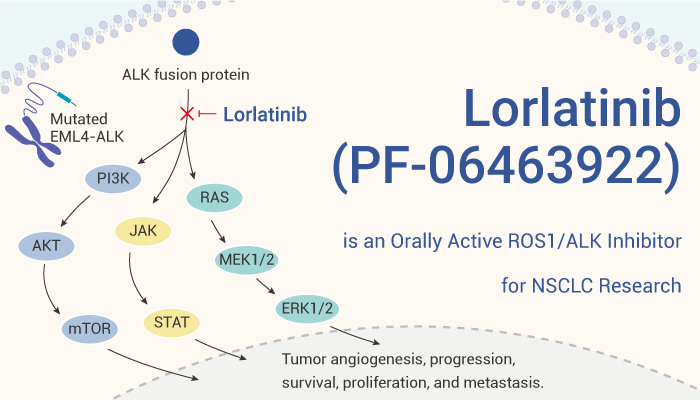ROS1 (c-ros oncogene 1) is a receptor tyrosine kinase encoded by the gene ROS1. Importantly, ROS1 is a proto-oncogene and highly expressed in a variety of tumor cell lines, belonging to the sevenless subfamily of tyrosine kinase insulin receptor genes. Besides, ALK (Anaplastic lymphoma kinase) is a member of the insulin receptor (IR) subfamily of receptor tyrosine kinases. Particularly, The receptor ALK plays a pivotal role in cellular communication and the normal development and function of the nervous system. Meanwhile, ALK and ROS1 rearrangements represent the two most frequent fusion targets in lung adenocarcinoma.

In this article, we will introduce a potent, selective, orally active, brain-penetrant and ATP-competitive ROS1/ALK inhibitor, Lorlatinib.
Lorlatinib shows Ki values of <0.025 nM, <0.07 nM, and 0.7 nM for ROS1, wild-type ALK, and ALKL1196M, respectively. Besides, Lorlatinib potently inhibits the proliferation of HCC78 and BaF3 CD74-ROS1 cells with IC50 values of 1.3 and 0.6 nM, respectively. In addition, Lorlatinib decreases the expression of phosphorylation of SLC34A2-ROS1 and downstream signaling molecules SHP2, Erk1/2, and AKT in a dose-dependent manner in HCC78 cells. Moreover, Lorlatinib (0, 0.03, 0.3, 3, 30, 300 nM) also increases the expression of apoptotic effecter cleaved caspase 3 in a dose-dependent manner. Additionally, Lorlatinib Inhibits Crizotinib-Resistant Mutant ROS1G2032R and ROS1L2026M Gatekeeper Mutant with Ki values of 12, 0.1 nM, respectively.
Lorlatinib (10 mg/kg for p.o.; 1 mg/kg for i.v.) has low plasma clearance, a moderate volume of distribution, a reasonable half-life (2.7 h), and a bioavailability of 100%. Furthermore, Lorlatinib (0.2-1 mg/kg; daily for 7 days) inhibits the growth of established FIG-ROS1(S) and CD74-ROS1 tumors with 84% to >100% inhibition. Moreover, PF-06463922 can induce marked tumor regression at single-digit nanomolar concentrations in tumor models expressing FIG-ROS1(S) or CD74-ROS1 fusions.
As a result, Lorlatinib is a novel small-molecule ROS1/ALK inhibitor and has the potential for the research of NSCLC.
Reference:
[1] Johnson TW, et al. J Med Chem. 2014 Jun 12;57(11):4720-44.
[2] Zou HY, et al. 2015 Mar 17;112(11):3493-8.